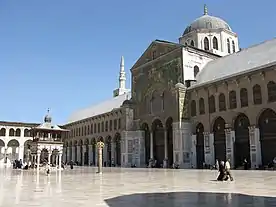| Great Mosque of Raqqa الْجَامِعُ الْكَبِيرُ فِي الرَّقَّةِ | |
|---|---|
| Religion | |
| Affiliation | Islam |
| Region | Levant |
| Location | |
| Location | Raqqa, Syria |
| Geographic coordinates | 35°57′7″N 39°1′15″E / 35.95194°N 39.02083°E |
| Architecture | |
| Type | Mosque |
| Style | Islamic architecture |
| Completed | 772 |
| Specifications | |
| Minaret(s) | 1 |
| Shrine(s) | 1 |
| Materials | Mud brick |
The Great Mosque of Raqqa (Arabic: ٱلْجَامِع ٱلْكَبِير فِي ٱلرَّقَّة, romanized: al-Jāmiʿ al-Kabīr fi ar-Raqqah) or Al-Qadim Mosque (Arabic: مَسْجِد ٱلْقَدِيم, romanized: Masjid al-Qadīm) is the oldest mosque in Raqqa, Syria, located at the northern section of the city's heart. It has a rectangular plan (108 meters (354 ft) x 92 meters (302 ft)) with 1.7 meters (5.6 ft) thick mud brick walls fortified with semi-circular towers at the corners.[1] The outer walls of the mosque are constructed of mud bricks supported by solid semi-circular buttress towers. The prayer hall consisted of three arcades supported on cylindrical piers, whilst the other three sides were lined with double arcades. The building is decorated with stucco, traces of which survive.[2]
The mosque was built by the Abbasids in 772 CE, under the reign of caliph al-Mansur. All that remains of the mosque today are the baked brick minaret (25 meters (82 ft)) and the prayer hall (haram) façade with eleven arches that were added by Nur ad-Din Zangi during the 1165 renovation of the mosque.[1][3] The mosque is currently in ruins. There used to be a small shrine in the center attributed to Wabisa Ibn Ma'bad Al-Asadi.
Damage
The first damage to al-Qadim Mosque occurred under ISIS-control of the city. DigitalGlobe satellite imagery illustrated that between October 2013 and February 2014, the small Ottoman-period shrine built in 1836 CE, around the purported grave of Wabisa Ibn Ma’bad al-Asadi, a companion of the Prophet Muhammad, was bulldozed. Images were later released of the shrine's destruction.[4]
In June 2017, at the start of operations by the US-backed Syrian Democratic Forces and the Raqqa Media Office reported that shelling had struck the mosque and the surrounding areas, resulting in casualties.[4]
Cemetery
The courtyard of the mosque was a graveyard for residents who could not make safe to cemeteries.[4]
References
- 1 2 Great Mosque of Raqqa Archived 2010-12-13 at the Wayback Machine Archnet Digital Library.
- ↑ Petersen, 1999, p.245.
- ↑ Raqqa: the Great Mosque Archived 2009-01-05 at the Wayback Machine Come to Syria.
- 1 2 3 "Incident Report Feature: al-Qadim Mosque". ASOR Cultural Heritage Initiatives. 2017-11-07. Retrieved 2019-02-20.
Bibliography
- Peterson, Andrew (1999). Dictionary of Islamic Architecture. Routledge. ISBN 0-415-21332-0.



